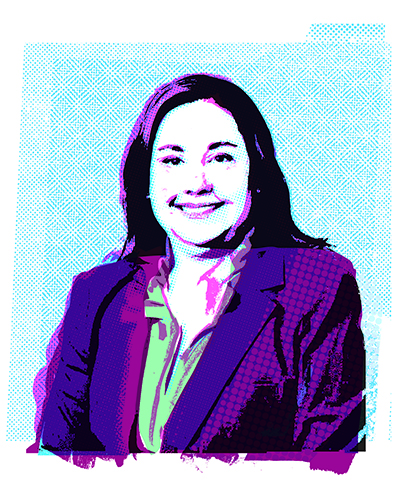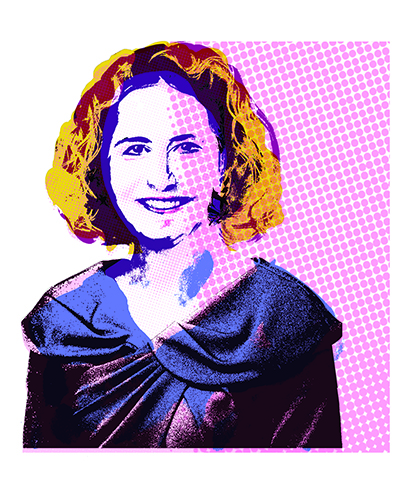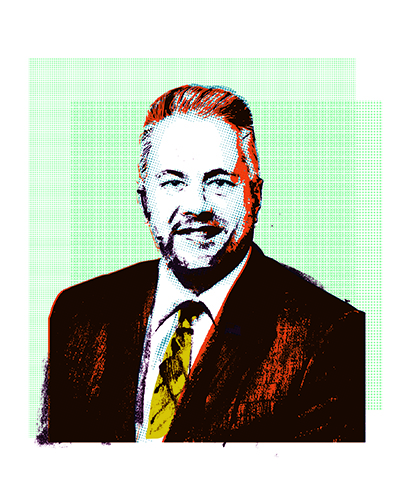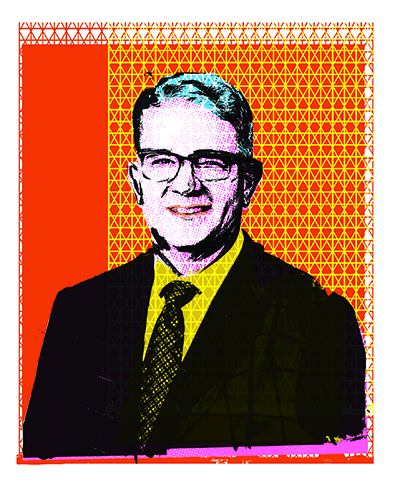New Voices on the Hill
First-term members of the US House of Representatives reflect on the intersection of science and policy, and what drives their work.
Yadira Caraveo

Illustration by Shonagh Rae.
Congresswoman Yadira Caraveo, MD (D-CO) is a pediatrician and previously served in the Colorado state legislature. She represents Colorado’s Eighth (and newest) Congressional District, which includes Thornton, Greeley, and Commerce City.
How does your experience in science, technology, engineering, or medicine (STEM) and related fields affect how you think about issues that come before Congress?
Caraveo: Being trained in a STEM field gives you a different way of thinking and looking at problems. In particular, my training in medicine has translated well to legislating because I use the same approach: listening, synthesizing a lot of information, deciding what the most pressing problem is, and developing a solution. And that’s exactly how we should approach the problems and solutions in our communities and our country.
As a lawmaker, what do you see as the most important policy issues facing the country and your district that science and technology can help address?
Caraveo: Clearly one of the most important issues facing the country and my district is climate change. This was an issue I saw impacting kids I took care of in clinic every day—the effects of poor air quality, heat waves, and pollution on their health. But the good news is that science and technology are well-positioned to address this issue by focusing on clean energy solutions and mitigating the effects of climate change that we’re already seeing.
Roughly 23% of the US workforce can be considered STEM workers. What are the STEM workforce challenges that matter to your district?
Caraveo: Colorado has a huge STEM workforce, which is affected by the same economic issues a majority of Coloradans are dealing with: the rising cost of living, with housing in particular. As Colorado has grown in population, we’ve seen increasing housing prices and a lack of supply, which really impacts residents’ quality of life and the talent we can attract and retain in our state.
Where do you go to get expert insights or data to help with decisionmaking?
My training in medicine has translated well to legislating because I use the same approach: listening, synthesizing a lot of information, deciding what the most pressing problem is, and developing a solution.
Caraveo: Another way that being a doctor translates well to legislating is that you’re used to consulting specialists to inform your care of the patient. Now, as a member of Congress, I tap into subject-matter experts in Colorado and across the country who have valuable insights into the solutions Congress should be looking at for any given problem.
Since the start of your term, what has surprised you most about the process of lawmaking?
Caraveo: Despite being somewhat prepared for this, I was still surprised by the slow pace of the legislative process in Congress. As a state lawmaker in Colorado, our legislative sessions lasted only 120 days, so we moved at a much quicker pace. In Washington, the pace at which we move the ball forward on solutions can be frustrating.
Which policies are most important for addressing your constituents’ biggest concerns about technology?
Caraveo: As a pediatrician, I’ve seen the rise of social media in kids’ lives and the ways in which it has affected their mental health. In particular, I’ve seen the isolation it fosters. That only increased during the COVID-19 pandemic, and it’s something I’m very concerned about. Now one third of young women in the US have contemplated suicide just in the last year; that’s one telling example of the effects of technology and the pressures it puts on young people’s lives.
Jen Kiggans

Illustration by Shonagh Rae.
Congresswoman Jen Kiggans (R-VA) served in the US Navy as a helicopter pilot for a decade before becoming a geriatric nurse practitioner and member of the Virginia Senate. She now represents Virginia’s Second Congressional District, which includes Virginia’s Eastern Shore; the cities of Virginia Beach, Suffolk, and Franklin; and is home to several military bases.
How does your experience in STEM and related fields affect how you think about issues that come before Congress?
Kiggans: I’m a geriatric nurse practitioner; one thing nurses do well is listen. I often tell the story of a question I got wrong on a test during nursing school. The question went something like, “When a patient is complaining that they’re in pain, what’s the first thing you do?” The first thing that came to mind was to take their temperature or blood pressure, but the correct answer was to listen to and believe the patient. I think Congress would be a lot better off if people were better listeners. Engaging in respectful, policy-focused conversations is a cornerstone of our government—and something that seems to be increasingly rare. I learned to be a good listener and a critical thinker as a nurse, and I use those skills every day in Congress.
As a lawmaker, what do you see as the most important policy issues facing the country and your district that science and technology can help address?
Kiggans: I see our ability—or really lack thereof—to manufacture advanced semiconductors, or chips, as one of the most important issues facing the country. It is important to my district, to our military, and to our national security.
The United States used to make 40% of the world’s chips, but now we make only 12%. As of 2019, nearly four-fifths of global chip fabrication capacity was in Asia. We cannot afford to keep falling behind while the Chinese Communist Party spends billions of dollars to become the world’s leading producer of advanced semiconductors. Science and technology can help us address this threat to our national security.
Roughly 23% of the US workforce can be considered STEM workers. What are the STEM workforce challenges that matter to your district?
Kiggans: We’re seeing STEM workforce challenges negatively impact our ability to meet the defense industrial base’s manufacturing needs in southeast Virginia. There’s a massive demand for welders, technicians, electricians, maintainers, and other skilled workers with a STEM education—especially in the defense industry and for ship repair companies and shipbuilders in Virginia.
Where do you go to get expert insights or data to help with decisionmaking?
Kiggans: I always want to hear from the people on the ground, the people who see firsthand the problems we’re trying to fix. Once I have that perspective, I consult with the relevant committee(s) here on Capitol Hill who have experts dedicated to conducting research, collecting data, analyzing the impacts of certain policies, etc. I also discuss matters with local stakeholders who have an intricate knowledge of our district and how federal policy affects our communities at all levels. That’s how I make decisions and do what I believe is best for southeast Virginia and for the country as a whole. I always have my district front-of-mind when working in Washington—or anywhere else.
Since the start of your term, what has surprised you most about the process of lawmaking?
Kiggans: I never believed lawmaking was as partisan as it was made out to be. But in Washington, it’s a lot harder to find people willing to work across the aisle than I imagined.
We cannot afford to keep falling behind while the Chinese Communist Party spends billions of dollars to become the world’s leading producer of advanced semiconductors.
Politicians of both parties often forget that their constituents sent them to Washington to deliver results and move the government in the right direction, not to endlessly fight with their colleagues. I am proud to represent a district with a wide range of viewpoints and I try to prioritize what is best for the country. I’m proud to have introduced several bipartisan bills already in the 118th Congress, particularly in the veterans and health care spaces.
Which policies are most important for addressing your constituents’ biggest concerns about technology?
Kiggans: I’m blessed to represent a very diverse district, one that ranges from very suburban to very rural. Our rural communities benefit greatly from expanded broadband access, something that I proudly support. I am also proud to represent one of the largest servicemember and veteran populations in the country. Any technological innovation that supports advances in our national defense capabilities or how we care for our veterans is important to so many people in my district.
Last but certainly not least, supporting policies that improve quality and affordability of life—whether through encouraging innovation, lowering health care costs, or improving the results and longevity of products—will always be a priority for me.
Eric Sorensen

Illustration by Shonagh Rae.
Congressman Eric Sorensen (D-IL) served as a local TV meteorologist for over two decades before running for Congress. He represents Illinois’ Seventeenth Congressional District, which spans central and northwestern Illinois.
How does your experience in STEM and related fields affect how you think about issues that come before Congress?
Sorensen: When I was a local meteorologist, it was my job to not only predict the weather, but to keep people safe and help them understand why there are more tornados, stronger storms, and greater floods. All this can be explained using science. In Congress I do the same thing by giving people the correct information they need so they can make the right decisions for their families and communities.
As a lawmaker, what do you see as the most important policy issues facing the country and your district that science and technology can help address?
Sorensen: Science and technology are powerful tools our nation can employ across many aspects of our lives. One issue we are facing is climate change and extreme weather. So much research is being done to develop solutions to address this challenge in agencies such as the Department of Agriculture and the Department of Energy. But as we adopt new technologies, new questions occur that need new science. For example, as more Americans make the shift to electric vehicles, some people worry about the range of the vehicle’s battery. And that’s where science helps, in the process of building batteries with longer charges and chargers that are faster. The challenge is not only coordinating all this research and change, but also communicating it to the public.
Roughly 23% of the US workforce can be considered STEM workers. What are the STEM workforce challenges that matter to your district?
Sorensen: My district is home to Collins Aerospace in Rockford, Illinois. In testimony to the House Science, Space, and Technology Committee earlier this year, a representative from the company told the committee about the need for robust research and development funding. Some companies are looking outside of the United States for such funding, and we must find ways to reorient that so we can inspire future generations of people wanting to go into STEM.
Where do you go to get expert insights or data to help with decisionmaking?
When we focus on the issues that matter to the people we represent, there are a lot of things we can get done by working together.
Sorensen: As a local meteorologist, I relied on NASA and its data to help me predict the weather. Now as a member of Congress, I am relying on NASA and other organizations to help me make decisions that best serve our farmers in central and northwestern Illinois. I recently took a tour of NASA’s Earth Information Center and learned how scientists there are using real-time data from satellites to measure groundwater, ocean temperatures, soil health, and so much more. Using these data points is critical in making decisions that impact our daily lives. For example, information on groundwater helps farmers determine which crops, if planted, will produce the greatest yield. For consumers, this impacts what you see when shopping at your local grocery store and how much you are paying when you check out.
Since the start of your term, what has surprised you most about the process of lawmaking?
Sorensen: People often talk about the dysfunction in Washington, DC. And of course they’re right to make note of it. However, even while serving in the minority as a freshman, I have been able to work across the aisle. For example, I have been able to work closely with some of my Republican colleagues in Illinois to help bring federal dollars back to our state to support critical projects that will help working families. I have also worked with some of the Iowa Republicans in the House to support conservation efforts and our farmers. When we focus on the issues that matter to the people we represent, there are a lot of things we can get done by working together.
Which policies are most important for addressing your constituents’ biggest concerns about technology?
Sorensen: I serve on the House Science, Space, and Technology Committee here in Congress. Earlier this year, we held a hearing on artificial intelligence. Just days before, I had had a meeting with transit workers who fear that autonomous vehicles will replace their jobs. As AI develops, there is anxiety about what will happen to our existing workforce. One issue Congress must address is to determine the guardrails within which AI should operate. How do we audit the systems before they are rolled out? When should AI be used? Should the user of a technology or service be informed when AI is being used? These are all questions we need to consider, and the answers will impact the working families I represent in central and northwestern Illinois.
Brandon Williams

Illustration by Shonagh Rae.
Congressman Brandon Williams (R-NY) is an entrepreneur, business owner, and former nuclear submarine officer for the US Navy. He represents New York’s Twenty-Second Congressional District, which includes Syracuse, Utica, and Rome.
How does your experience in STEM and related fields affect how you think about issues that come before Congress?
Williams: I am the first nuclear submarine veteran to serve in Congress in fifty years (and only the second in our nation’s history). I qualified on two separate naval nuclear reactor designs and have thousands of hours of experience supervising the operations of nuclear power plants. This experience and depth of technical knowledge affects my thinking in two ways: first, I naturally create “systems engineering” models in my head that help me understand issues. Too often in government policies, the legislative “cure” to a problem fails to anticipate adverse effects that often result. Thinking in terms of a system helps me ask questions and seek alternatives that respect the realities revealed by physical and social science. Second, I have spent decades trying to understand how things work—from technologies to industries to geopolitics. Having a strong foundation in STEM-based training and jobs enables me to quickly sift through lots of technical information to get to the underlying policy issue. Overall, these tools allow me to contribute to the conversation in a different way than most of my colleagues.
As a lawmaker, what do you see as the most important policy issues facing the country and your district that science and technology can help address?
Williams: We must rebalance our nation’s investment in energy infrastructure. Recently, the world witnessed the terrible costs and consequences of Europe’s overreliance on and overinvestment in renewables. Energy, in all its many forms and uses, is fundamental to our economy and our way of life. The United States appears to have learned nothing from the European Union’s pivot to nuclear and natural gas to keep energy affordable, reliable, responsible, and resilient. It is estimated that the United States has embarked on a $6.6 trillion investment in renewable energy, while allocating a relatively tiny amount toward advanced nuclear and innovation.
Thinking in terms of a system helps me ask questions and seek alternatives that respect the realities revealed by physical and social science.
We must stop this imbalance and reengineer our nation’s energy infrastructure investment strategy. I support an “all-of-the-above” energy strategy. However, a vast amount of federal incentives are going exclusively to renewable projects. We know that renewables aren’t efficacious everywhere—I live near Syracuse, for example, the second cloudiest city in America. There is also not yet an energy storage solution that can offset the reality of renewables’ intermittent generation. We have let politics and not engineering and economic realities drive our strategy. But it’s not too late to turn the ship around.
Roughly 23% of the US workforce can be considered STEM workers. What are the STEM workforce challenges that matter to your district?
Williams: America has allowed our manufacturing and technology leadership to languish here at home while driving skilled manufacturing offshore, particularly to China. And this has hollowed out whole ecosystems of skills and competencies in the STEM workforce. Central New York has weathered an exodus of manufacturing jobs over the last 60 years. There are still many highly technical companies in the defense sector that have core manufacturing facilities in our communities. And we are anticipating the single largest manufacturing investment in American history in the Syracuse suburbs: Micron Technologies has committed as much as $100 billion to build a state-of-the-art memory-chip manufacturing facility. This will create thousands of jobs directly and tens of thousands of jobs indirectly through suppliers to Micron’s operations.
The conundrum is that our community needs thousands more workers. Community, industry, government, and education leaders across central New York are investing in workforce development and STEM education. It’s incredibly exciting. But my central message is that we need our children and grandchildren who moved away in pursuit of better jobs to move back and help our communities thrive again. We also cannot afford to leave anyone behind—we need every working-age citizen to participate to make the most of the opportunity that this economic miracle presents. Workforce development is absolutely critical.
Where do you go to get expert insights or data to help with decisionmaking?
Williams: I spend a lot of time talking to experts, such as the scientists at our nation’s premier energy laboratories. I ask a lot of detailed questions about the science, the research, the techniques, and the tools that they use and need to advance our energy research. I also talk with private industry representatives to understand the outlook and investments driving their decisions. And lastly, when time allows, I like to read technical journals that offer dispassionate and thorough analyses of issues and trends. I prefer to ingest a lot of information to form my own working model and understanding. And I use new information to constantly challenge my assumptions and conclusions. I tell my staff, “I don’t mind being wrong, but I hate to be ignorant!”
Since the start of your term, what has surprised you most about the process of lawmaking?
Williams: My observation is that lawmaking is more about persuasion and influence than power and control. As a freshman member, I don’t have direct power to change things. I would add that, to be an effective lawmaker, you need to carefully pick your lane(s) of passion, expertise, and influence and focus all your efforts in just one or two places. Focusing energy always results in more work produced. (I hope the physicists reading this appreciate the oblique reference.)
Which policies are most important for addressing your constituents’ biggest concerns about technology? Williams: People are concerned about the rapid pace of change in our society and economy, much of it driven by new technology. Examples include everything from TikTok to electric vehicles. I believe my constituents want leaders who understand the rapidly growing complexity of technology, the economy, and how things work. And they want leaders who can fight for our region’s interests, considering the change that technology brings.
